A lesser-known luminary of the early Italian Renaissance was Fra Filippo Lippi whose painting of the Annunciation is a glorious display of artistic intuition and perception. Before the analysis of this magnificent work, let’s understand a little about who he is and how he fits into the overall panorama of Renaissance artists.
A Colorful Figure
The 1400s was the era of the early Renaissance in Italy that prepared the way for the better-known figures of the high Renaissance like Michelangelo and Leonardo. Lippi lived entirely in the 15th century (1406-1469) and was the product of Florence’s intense artistic culture during the reign of the Medici family.
All of the Renaissance greats who flourished in the early 1500s knew the works of Fra Filippo Lippi. He was, as the saying goes, a “colorful” figure, and not just with paint.
The designation “Fra” means that Lippi was a Franciscan priest. Apparently he wasn’t a very good one, but I certainly don’t hold the man’s faults against him. We are all flawed! Despite that, Fra Filippo was a very good artist, which is why we remember him. The Encyclopedia Britannica’s bio describes his life this way:
[T]radition has given him the reputation (borne out in great part by documents) of a man dominated by love affairs and impatient of methodical or tranquil conduct. His adventures culminated in 1456 in his romantic flight from [the city of] Prato—where he was painting in the convent of the nuns of Santa Margherita—with a young nun of the convent, Lucrezia Buti.…Lippi’s conduct, together with his apparent inability to fulfill contracts on time, got him in trouble. He was arrested, tried, and tortured. It was only thanks to the intervention of Cosimo de’ Medici that Lippi was released and allowed to renounce his vows. The pope later gave permission for the former priest-painter and the nun to marry, and from this union was born a son, Filippo, called Filippino, who was to be one of the most noted Florentine painters of the second half of the 15th century.
Well, Fra Filippo found his true vocation…eventually! It is certainly one of those ironies of history that Filippo Lippi’s son also became a famous Renaissance painter.
One final colorful fact about Filippo Lippi: as a young man he was abducted by Muslims and held as a slave until he painted a portrait of his captor! The artist would be a prime candidate for his own reality TV show if he were alive today.
A Masterwork of Perception
Let’s get right to Lippi’s marvelous painting of the Annunciation. He painted it for the Palazzo Medici, the family palace, sometime between 1449 and 1459 when the palace was being built. It fills a lunette (the semi-circular space over a door) and is one of a series of paintings he did for the same Palazzo.
The breathtaking delicacy of this painting appeals to the keen observer because its beauty and messaging is subtle, perceptive, and complex yet simple at the same time. [The viewer can click on the image below for a high-resolution view of this painting that will help in our analysis.]
Believe me, the details, when viewed up close, are a feast of beauty.
The Structure
Given his semi-circular space limitations, Lippi couldn’t use a standard rectangular canvas so he fit the scene into the space available, adapting the action and the figures accordingly. Note that the two figures in the painting are slightly bowed toward each other. This is both a depiction of their humility and also an adjustment to the contours of the rounded frame (notice the conformity of the outer line of the angel wings on the left to the edges of the frame). Also notice the Father’s blessing hand perched at the exact top and center of the image as if descending from the heavens.
The scene is split in two by the vertical column and flower vase, with radically different settings on either side. The Archangel Gabriel is on the outside of the house, immersed in nature, symbolic of his coming from another world, while Our Lady is inside, which is symbolic of the “enclosed garden” imagery often associated with her perpetual virginity, Song of Songs 4:12.
The two-fold structure of the painting, which nonetheless feels like a harmonious whole, also draws the reader’s mind to the dual nature of the God-Man, who takes flesh in the womb of the Virgin at that very instant of time.
Such incredible symbolism emerges from the artist’s deep perception about the mystery he is depicting. But the structural design doesn’t exhaust the imagery.
The Angel
The Archangel Gabriel who was sent by God to make this world-changing announcement is depicted by Lippi as a boy! He is not one of those baby angels up in the clouds playing a harp; nor is he one of the more frightening angels of the Book of Revelation. He is dignified, a handsome young boy with curly hair and an innocent face – the perfect messenger to deliver the message of life on high. His head is bowed as if he is fully aware that he in the presence of his Queen, yet his eyes look straight at her as the object of his mission.
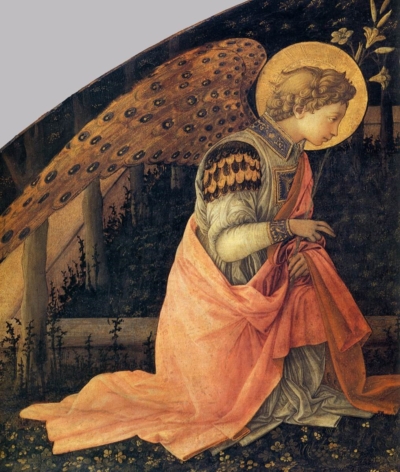 This paradox can be seen in Gabriel’s name, which means “strong man of God” in Hebrew (Gabor-El), even though he is depicted as a boy. Yet, he is dressed in the garb of a strong man: a military-style outfit with stiff collar, breastplate, and even stylized epaulets on the shoulder. His tunic is white and his outer garment is red, his halo is pure gold, all colors symbolizing heaven and holiness.
This paradox can be seen in Gabriel’s name, which means “strong man of God” in Hebrew (Gabor-El), even though he is depicted as a boy. Yet, he is dressed in the garb of a strong man: a military-style outfit with stiff collar, breastplate, and even stylized epaulets on the shoulder. His tunic is white and his outer garment is red, his halo is pure gold, all colors symbolizing heaven and holiness.
His right hand is outstretched in blessing. Notice that it mirrors, almost exactly, the form of the Father’s hand that extends down from heaven. His blessing is the Father’s blessing. He comes to do God’s will, not his own.
One final detail: the angel wings. They are full of eyes! Here, one thinks of peacock feathers – the most illustrious birds in the natural world – but it is more likely that the eyes symbolize the all-seeing wisdom of God, present in the eternal plan of salvation which Gabriel announces to the Virgin.
The highest angels of wisdom (the Cherubim) are depicted in scripture as “covered with eyes” (see Ezekiel 1 and Revelation 4), and I take it as a very perceptive detail that Fra Filippo Lippi painted a different type of angel, an Archangel, with such eyes, as if the whole host of heaven comes on the wings of Gabriel and is “watching” the girl in breathless anticipation as she ponders her decision.
The Virgin Mary
Our Lady is seated, but her chair is less a piece of household furniture than it is a throne, covered by golden, embroidered cloth with red borders. She is a Queen, the queen of the angels and the Mother of God.
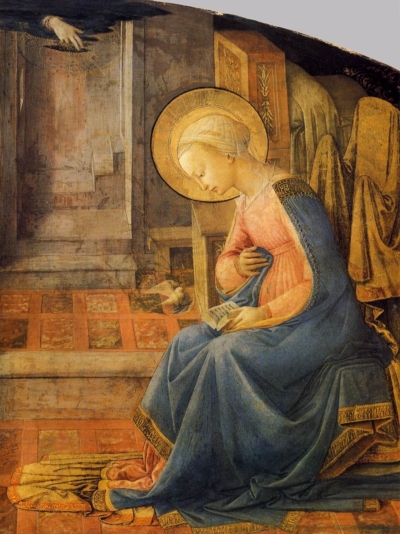 Her red and blue garments are the traditional royal colors in which Renaissance painters depicted Our Lady. She is surrounded by interior scenery which exhibits the sedate colors of earth: bland grey walls, terra cotta tilework, dark furniture, etc. By such coloring, the artist sets Our Lady off from the rest of the scene, but she is not depicted in radiant garb as a divine being. She has been chosen to give her human nature to the God-man.
Her red and blue garments are the traditional royal colors in which Renaissance painters depicted Our Lady. She is surrounded by interior scenery which exhibits the sedate colors of earth: bland grey walls, terra cotta tilework, dark furniture, etc. By such coloring, the artist sets Our Lady off from the rest of the scene, but she is not depicted in radiant garb as a divine being. She has been chosen to give her human nature to the God-man.
Like Gabriel’s halo, Mary’s is pure gold, symbolizing her purity and holiness. As I mentioned elsewhere, the early Renaissance usually featured opaque, golden halos as a holdover from earlier icon painting, but later Renaissance artists would craft more delicate halos in the form of single, ethereal lines and lace-like circles of light.
Our Lady’s veil is pure beauty, a delicate, almost transparent film of light descending from the halo. This gossamer-style veil reflects the technique of other artists of the early Renaissance – Botticelli, in particular – which was carried into the later Renaissance with great effect.
The Trinitarian Element
The Virgin Mary bows her head in humility as we almost hear her say, “Fiat – Behold, I am the handmaid of the Lord. May it be done to me according to your word” (Luke 1:38). Then, we see the wonderful and curious effect that Lippi has placed discreetly into his scene:
At the very place on her body where the womb is located, we see an opening in the garment. You have to look closely for it, which is why the high-resolution picture is so helpful here.

It is the symbolic entry point of the Word of God into the world of men. This is also why Our Lady holds a book in her lap, a symbol of the Word, which she “ponders in her heart” (Luke 2:19). The Word now enters both her heart and her body, making Mary herself the actual doorway for God’s entry into the world.
If you follow the tiny gold lines from the entry point outward they will lead you to an almost transparent dove who hovers before that very spot. It is an obvious symbol of the Holy Spirit, who the angel said would “overshadow” her and be the generative force of the Incarnation of the Son of God.
Then, following the swirling lines of gold backward and upward from the dove, we arrive at the Father’s hand of blessing from heaven, from which all blessings come. We could easily miss these fine details looking at it from a distance. They symbolize divine grace itself in graphic form.
Grace and Truth
We would expect such theological accuracy from a priest artist! He has woven into a half-circle space an incredibly subtle and beautiful snapshot of the very moment when “the Word became flesh and made his dwelling among us” (John 1:14).
Fra Filippo Lippi’s painting is full of grace and truth; it is inspiring to look at; it raises our hearts to heaven; it fills us with admiration of such a good God who did not leave us abandoned to the power of sin and death but who came to rescue us in the fullness of time through the Fiat of a humble Virgin.

Soul Work
No one’s life is without meaning in God’s plan of salvation. Blessed John Henry Newman once wrote, “God has created me to do him some definite service. He has committed some work to me which he has not committed to another. I have my mission.”
What is your specific mission in life? If you are not totally clear about it, pray for insight. He has given you some work “which he has not committed to another.” The Lord makes His will known to the humble and to those who wish to offer their lives in service to Him.
Pray to know how your life fits into His divine plan for humanity. All those who ask to know the meaning of their lives receive an answer and, every now and then, a visit from an angel.
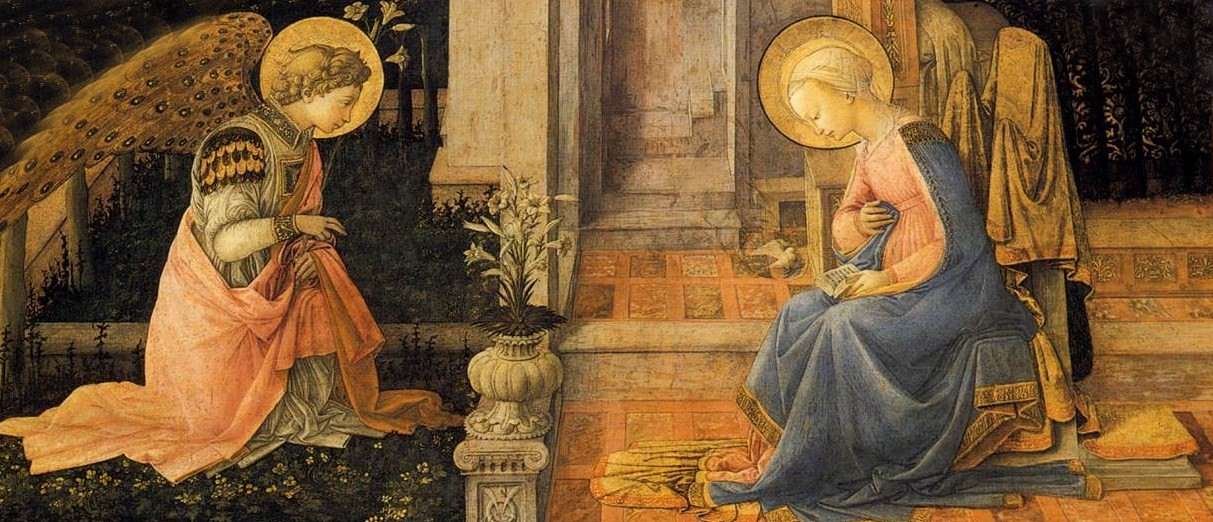
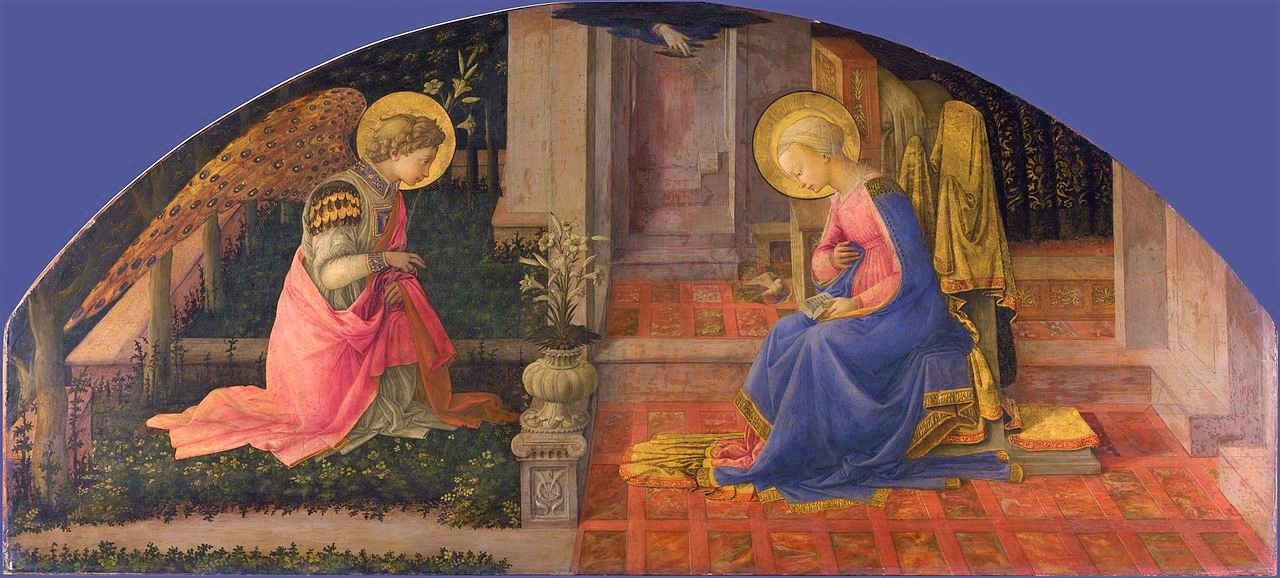

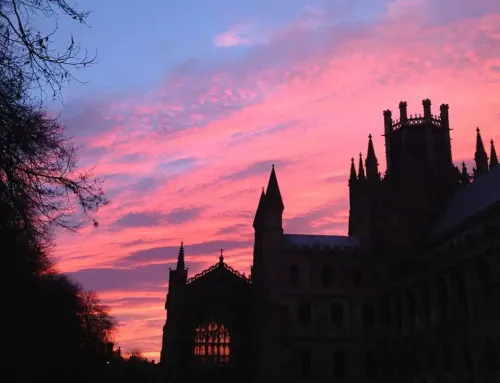
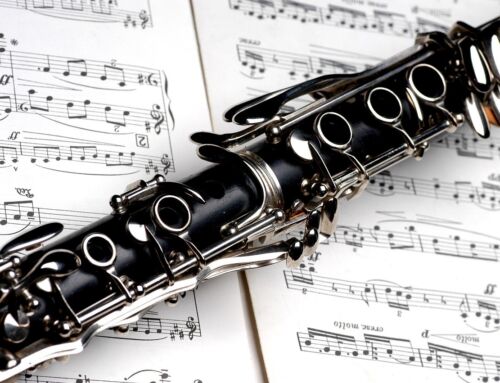
Just an awesome message with insightful facts about the painting of zthe zannuncistion. Bravo e grazie. DJS
Thank you for the kind feedback, David. All the best to you!